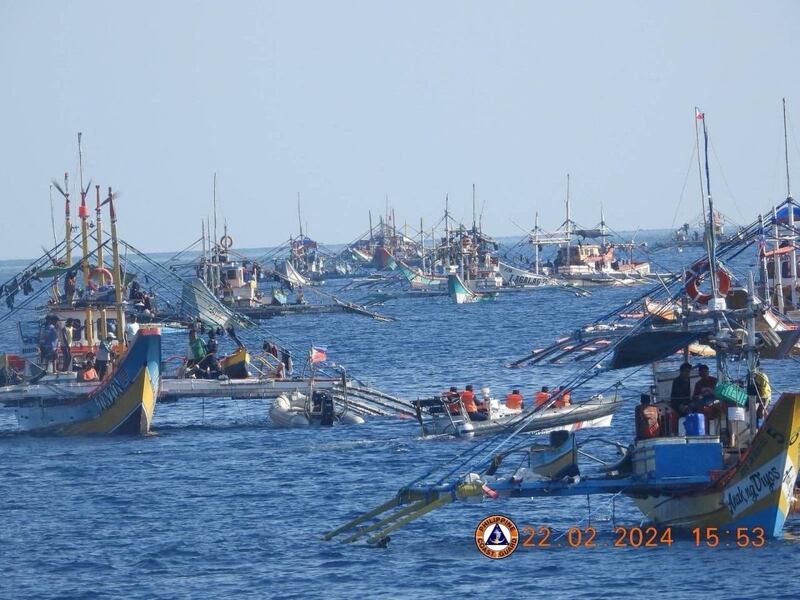Philippine President Ferdinand Marcos Jr. arrived in Australia on Wednesday for a two-day official visit where he plans to solidify security arrangements linked to concern about the reported presence of Chinese warships near traditional South China Sea fishing grounds.
Before departing for Canberra from the Villamor Air Base near Manila, Marcos shared a report by the Philippine Coast Guard indicating that crews had monitored at least three ships from China’s People’s Liberation Army Navy about 20 nautical miles from Bajo de Masinloc, the local name for Scarborough Shoal.
“It’s worrisome because there are two elements to that. One, is that before it’s only the Chinese Coast Guard were seen there. Now, there’s already the navy,” Marcos told reporters.
Marcos stressed that “the basic principle there is that the fishers must be allowed to fish in their traditional fishing grounds, which belong in the maritime territory of the Philippines.”
The government, he said, would “continue to support all of our fishermen, fisher folks who make their living from these fishing grounds.”
A recent report by the Philippine Coast Guard indicated that China was deploying its naval ships near the shoal to support its coast guard, Marcos said.
In Beijing, Ministry of Foreign Affairs spokeswoman Mao Ning said China’s position on the South China Sea was consistent.
“We express grave concern over the Philippines’ recent activities in the South China Sea that infringe on China’s sovereignty and will continue to take necessary measures to firmly safeguard our territorial sovereignty and maritime rights and interests, and keep the South China Sea peaceful and stable,” she told reporters on Wednesday.
Address to lawmakers
While in Canberra, Marcos was expected to raise concerns about the South China Sea during an address to the Australian Parliament.
“I anticipate an enhancement of the mutual understanding between the Philippines and Australia as we share a common vision not just for our bilateral relations, but for the peace and security of the region as well,” Marcos said before boarding his flight to Australia.
The president said that it was “worth mentioning that Australia and the Philippines are maritime nations and it cannot be denied that it will be something that will have to be raised as well.”
During a visit to Manila in September, Australian Prime Minister Anthony Albanese reaffirmed Canberra's support for Manila's South China Sea claims and improved defense ties.
Albanese and Marcos then signed a “Joint Declaration on Strategic Partnership.” It upgrades the bilateral partnership to include possible joint patrols in the South China Sea as well as more and larger joint exercises between Philippine and Australian forces.
Marcos said the strategic partnership between the Philippines and Australia “provides greater energy and optimism for closer cooperation that is mutually beneficial to both Filipinos and Australians.”

The Chinese have been in control of Scarborough Shoal since 2012 after a standoff with the Philippines.
The following year, then-President Benigno Aquino III filed a case against Beijing in an international arbitration court. In 2016, the court ruled in favor of Manila and invalidated China’s sweeping claims to the South China Sea on historical grounds. Beijing has never acknowledged the ruling and has refused to leave the area.
Aquino’s successor, Rodrigo Duterte, refused to make a move to compel Beijing. Instead, he sought to appease Beijing in exchange for promises of Chinese investments in the Philippines. This allowed Beijing to gain a firmer foothold in the region.
Marcos, who succeeded Duterte in 2022, has worked to repair defense ties with the United States.
In Washington on Wednesday, the Philippine ambassador to the United States said he did not expect Washington to change its strategy in the region should Donald Trump win a second term as president, after having contact with one of Trump’s advisers, Reuters news service reported.
“That is of course very consoling,” Jose Manuel Romualdez told a diplomatic gathering in the U.S. capital, according to Reuters. He noted that while a potential Taiwan conflict should be taken seriously, the “real flashpoint is the West Philippine Sea,” using Manila’s name for its South China Sea territories.
In Masinloc, a Philippine fishing community on Luzon island’s west coast overlooking the South China Sea and that has been affected by the Chinese control of the shoal, fishermen rejoiced that Marcos’ government appeared to have responded to their plight.
Still, a group of fishermen called Pamalakaya, which has members in Masinloc, said that while the government’s recent moves in Scarborough were welcome, much more needed to be done. They said that the China Coast Guard has been allowing Chinese fishermen to harvest giant clams while destroying the reef.
“The catch has dwindled a lot,” said Leonardo Cuaresma, one of the leaders of Pamalakaya in Masinloc, adding that many local fishermen who tried to return to the shoal have been chased away.
He said that he hoped that Marcos would be successful in “ending the bullying of the Chinese and for them to leave Scarborough.”
Another fisherman, Bobby Roldan, said there was “strong evidence” and testimonies by Filipino fishermen about China’s illegal activities on the shoal. He said Marcos’ position remains weak because he could not stop China from “continuing to take the West Philippine Sea.”
Jason Gutierrez and Jojo Riñoza in Masinloc, Philippines, along with Jeoffrey Maitem in Puerto Princesa, Philippines, contributed to this report.
